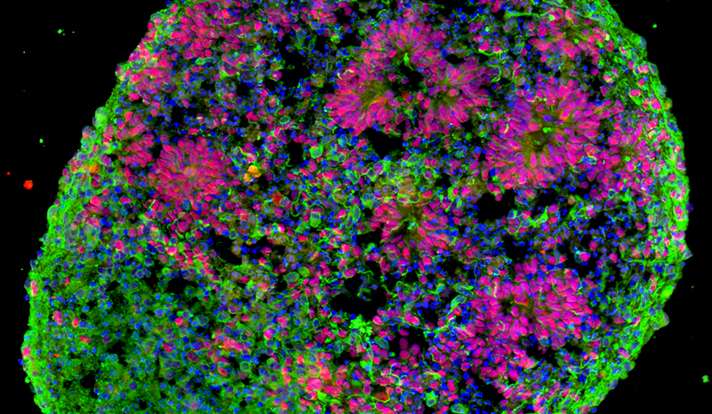Making 'miniature brains' from skin cells to better understand autism

A larger head size—or macrocephaly—is seen in many children with severe autism spectrum disorder (ASD). A new stem cell study of these children by Yale School of Medicine researchers could help predict ASD and may lead to new drug targets for autism treatment.
The findings are published in the July 16 issue of the journal Cell.
ASD is known to appear during brain development, but most cases of the disorder lack a clear origin or genetic basis. Recent studies of genetic mutations in rare cases of ASD hint that development of the cerebral cortex in the fetal period is abnormal in autism. The Yale research team sought to pinpoint what goes wrong as the cerebral cortex develops.
The team simulated early cerebral cortex development using stem cells generated from skin biopsies of four patients with ASD. They grew the stem cells into three-dimensional simulated miniature human brains (brain organoids). They then compared gene expression and developing cell types between the patients and their family members—typically their fathers—without ASD. Patients in the study had enlarged heads, which indicates worse autism outcomes.
"Brain growth abnormalities such as accelerated cell cycles, overproduction of inhibitory neurons, and synaptic overgrowth may all be precursors of a trajectory of brain development found in children with severe ASD," said the study's lead author Flora Vaccarino, the Harris Professor of Child Psychiatry and Professor of Neurobiology at Yale School of Medicine. "Our data provides a framework for studying normal human brain development and its disorders, including autism."
"We discovered that the patients' cells divided at a faster pace, and that they produced more inhibitory neurons and more synapses," Vaccarino added. She and her team also noted a 10-fold increase in a gene called FOXG1, which is important in the early growth and development of neurons in the embryonic brain.
"By regulating FOXG1 expression levels in patients' neural cells, we were able to reverse some of the neurobiological alterations," said Vaccarino. "Indeed, correcting the FOXG1 overexpression prevented the overproduction of inhibitory neurons in patient's cells. Remarkably, we also found a link between the extent of change in gene expression and the degree of a patient's macrocephaly and autism severity."
Vaccarino added that FOXG1 could be used as potential biomarkers or molecular signature of severe ASD and a potential drug target.
More information: FOXG1-Dependent Dysregulation of GABA/Glutamate Neuron Differentiation in Autism Spectrum Disorders, Cell, dx.doi.org/10.1016/j.cell.2015.06.034


















